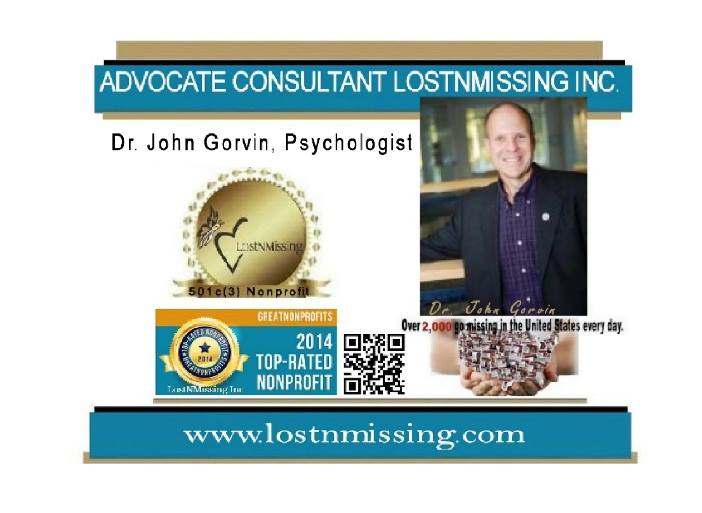LostNMissing Inc, 26 Noyes Rd., Londonderry, NH 03053 Phone: 603.548.6548.
Why kids run
By Dr. John Gorvin , Psychologist
Advocate Consultant for LostNMissing Inc.
Therapy Orientation: Psychological Testing, Cognitive Behavioral (CBT)
Specialties: Loss or Grief, Anger Management, Psychological Testing & Evaluation,
Mood Disorders, Anxiety or Fears, ADHD, Autism, Depression
It is hard for individuals to understand what draws people to make the same mistakes over and over, or repeat patterns of behavior that have negative consequences. There is some comfort with familiarity, even when the familiar experiences and people would be avoided by many others.
Some youngsters are much more vulnerable to being exploited, by virtue of their upbringing and circumstances. This article cannot fully explore how this occurs, but there are many sources describing this in detail, both in America and abroad. I have listed some references at the end of this article.
The following are some common risk factors for childhood sexual exploitation and running. This list is generated partly based upon my experience, and partly obtained from reading I have done.
Risk factors include:
- Exposure to neglect
- Exposure to emotional abuse
- Exposure to physical abuse
- Exposure to sexual abuse
- Academic difficulty
- History of running (these contribute to running initially, and then running is a risk factor that perpetuates the cycle).
- History of receiving foster care services
- Missing or absent parents
- Mental health and substance use issues
- Poverty
People who have been treated with neglect or abusively often develop a passivity and helplessness that is very difficult to overcome. In many cases these victims see (accurately) that their options are severely limited.
Children also lack the cognitive and psychological resources to resist avoid or escape their situations. Brain development is incomplete or delayed in many victims and their rational thinking and decision making skills are impaired. They also lack the social experience and skills to accurately assess and respond to the situations they encounter, and make ill informed decisions due to lack of maturity and experience.
The forms of exploitation an abuse are many, and the venues this can occur are numerous. This can be done in a very organized way, in the form of established prostitution rings, and can also be done in local towns in a very informal and discreet way, perpetrated by one individual against another single individual.
Holly Austin Smith and Rachel Lloyd describe in their books how they, like others, can be groomed for sexual exploitation. Many people end of in this situation in different ways, but once there, the common goal of the perpetrator is to exploit and entice the individual to comply with their demands, and they do so by controlling very aspect of their life.
The abusers can be strangers, family members, teachers, coaches or really anyone who is deviant enough and sick enough to willfully target and abuse children. Unfortunately, these individuals are also often smart enough and skilled enough to execute their twisted plans without detection, and often do this by ingratiating themselves to not only the children, but also their families.
Even children who are found and given shelter and assistance often end up back in the abusive situation they left or another similar abusive situation.
The advent of social media and the ease of access, day and night, at home and school, leave many children vulnerable to being found and re-exploited.
In the course of my work I try to encourage the children I evaluate to be vigilant and careful, and not to trust just anyone. I also try not to make them “paranoid” and be completely mistrustful, either. That is a difficult balance to strike, and at the risk of having children be overly vigilant and cautious, I err on the side of caution at times, as the consequences and risks of being too trustful are too great to ignore.
In closing, I still believe and want to emphasize that there are more good people out there than evil people, and children and their families need to try to remember that. However, it is true that the evil people can be sheep in wolves clothing, and a healthy dose of vigilance is necessary, especially in the modern, technologically driven world.
I also try not to make children become too fearful and essentially paranoid. There is a fine line between vigilance and hypervigilance for many people. I also never advocate for people to live their lives and explore new things. I always stress caution, however, and taking time to stop and think, and to consider that things are not always as they seem.
So parents, monitor your children’s internet activity, as well as whom they associate with. And children, as much as you hate it, remember your parents’ “hassling” you is generally done with good reason.
BOOKS:
Holly Austin Smith Walking Prey
Rachel Lloyd Girls Like Us
Siddarth Kara Sex trafficking: Inside the business of modern day slavery
Melissa Farley Prostitution, Trafficking and traumatic Stress
Neil Jacobsen and John Gottsman When men batter women
LINKS:

